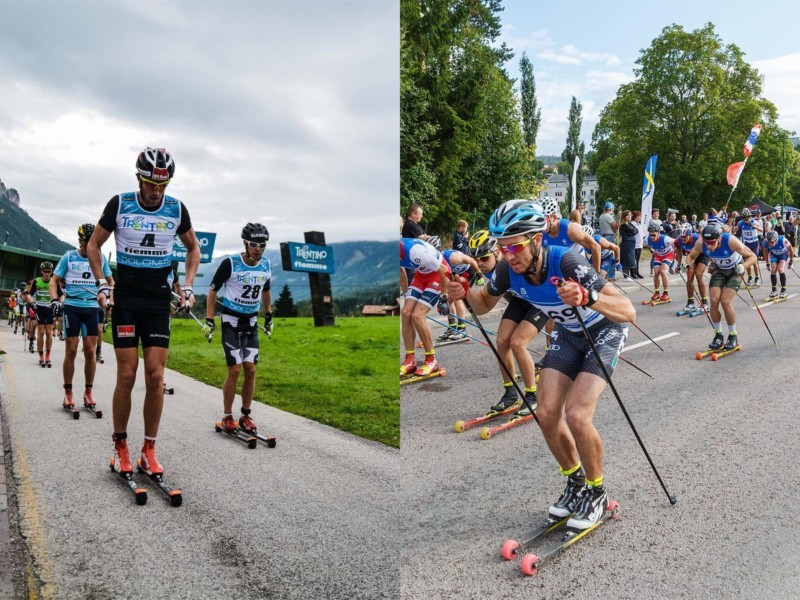
The eternal question for rollerski competitions of any size and importance : same gear for everyone or each to his/her own?
The Dailyskier went to ask some of the world’s top skiers as well as rollerski races organizers that very question:
Some rollerski races follow the rules of winter skis i.e. each racer performs on individually chosen and prepared skis.
Others ( e.g. Blink, Allianslopper, recent Fiemme Rollerski Cup) go the opposite way: every member of the elite performs on identical rollerskis provided by sponsor thus evening out the field somewhat
What is a right way in your opinion? Which of the two options above you prefer when competing?
We have received a lot of good, thoughtfull replies – and shall publish them in portions. Today’s turn of race organizers:
Ulf Stenman, organiser of Gold Coast marathon, Finland
– If we want a real Worldcup on rollerskis with the best skiers, everyone have to get the possibillity to use own skis. For the rollerski brands, poles producers and so on, it’s important to get their sponsored skier on the podium. Same way as in the winter. The only bad thing in this is the speed! And money!
From my point of view it’s unfortunately impossible now. It’s, of course, most fair if everyone compets on same skis, provided by a sponsor/brand. That just means its more difficult to get sponsors and skiers intrested – A Fischer skier wants to win on Fischer! Right now I go for identical skis. For the main skier its ok if the rules are ” skis with number 2 wheels” In the future I think the Ski Federation would have to find a solution that means everyone can participate on own skies. – maybe same wheels for all but own skies?
The Kanalrennet uses identical skis/wheels (size 2) for the top 40-50 athletes. We have discussed moving to size 3 to avoid having too much stretch between the elite and amateurs, but this is still to be decided
First, we have to remember cross-country skiing and roller skiing are two different sports, even if techniques and equipment have similarities. Asphalt and snow are two very different surfaces with different physical attributes. Asphalt is solid, snow is often loose. Asphalt is combination of oil and some collective element, snow is water. Therefore, the best possible way to gain top speed on both surfaces is dependent on physical elements, such as rolling resistance, air resistance, and friction if we consider only biomechanical elements without cardiovascular performance.
Due to varying requirements of these two different surfaces, the equipment used cannot be made in a same way. Rolling resistance for rollerskiing and friction for xc-skiing are the defining factors. This means xc-skis need to have some characteristics that roller skis do not have to and vice versa. Based on defining environmental, physical, and technological factors, rollerskis can be manufactured with much less variation between the units than xc-skis. Therefore, by pure technological means, it is not possible to set athletes in xc-skiing into the same level with equipment because you cannot make 100 pairs of similar-enough skis. However, with rollerskis, you are able to achieve this equity more likely due to environmental and manufacturial factors.
Why not to let athletes tune their equipment for roller ski races? Well, here are couple thoughts. First, speed is higher and surface is less forgiving in accidents. If athletes could tune their skis freely, it could lead to use equipment that is not safe for particular course. In mass start competitions, varying rolling of skis could expose for risks, since braking with rollerskis is very different in versus to xc-skiing.
Why to provide same skis for everyone? As stated above, we are talking about two different sports. Cross-country skiers are utilizing roller skiing as a training method, since it provides an opportunity to do sport-like training despite the conditions. It is same thing for mountain bikers: they can do road cycling for training but it is still not the same thing. Anyway, both sports in skiing have their own professionals. By providing the same equipment for cross country skiers in mass rollerski races, the event can have the athletes and audience focus more on the athlete performance itself than the benefit of equipment. Roller skiing is a side-sport for these athletes, when total performance is not the key but skiing performance is. Then, fans and athletes are able to see who has the best summer shape, maybe think about how do they perform in winter and so on. Basically this mean rollerskiing events are of course good training, but also a show for xc-skiing people. By providing same equipment for everyone, the show can be made a real mano-а-mano.
…Are you a rollerski marathon organizer with an opinion to share on the matter? Write to us at info@dailyskier.com – or just use our Comments option
Images courtesy of Fiemme Rollerski Cup and Kanalrennet
Related Posts
- 10 Reasons To Add Rollerskiing To Your Life
- Rollerskiing Is About Being Fit, Great Looking And Overall Cool . Why Industry Fails To Advertize That?!
- Science To Rescue: Our Rollerski Scraped Knees Would Heal Three Times Quicker With New Smart Bandage
- Interview: People Who Make Marwe Rollerskis
- Yelena Vyalbe: For Olympics 2026 We Will Prepare In Caucasus Mountains Rather Than Alps
